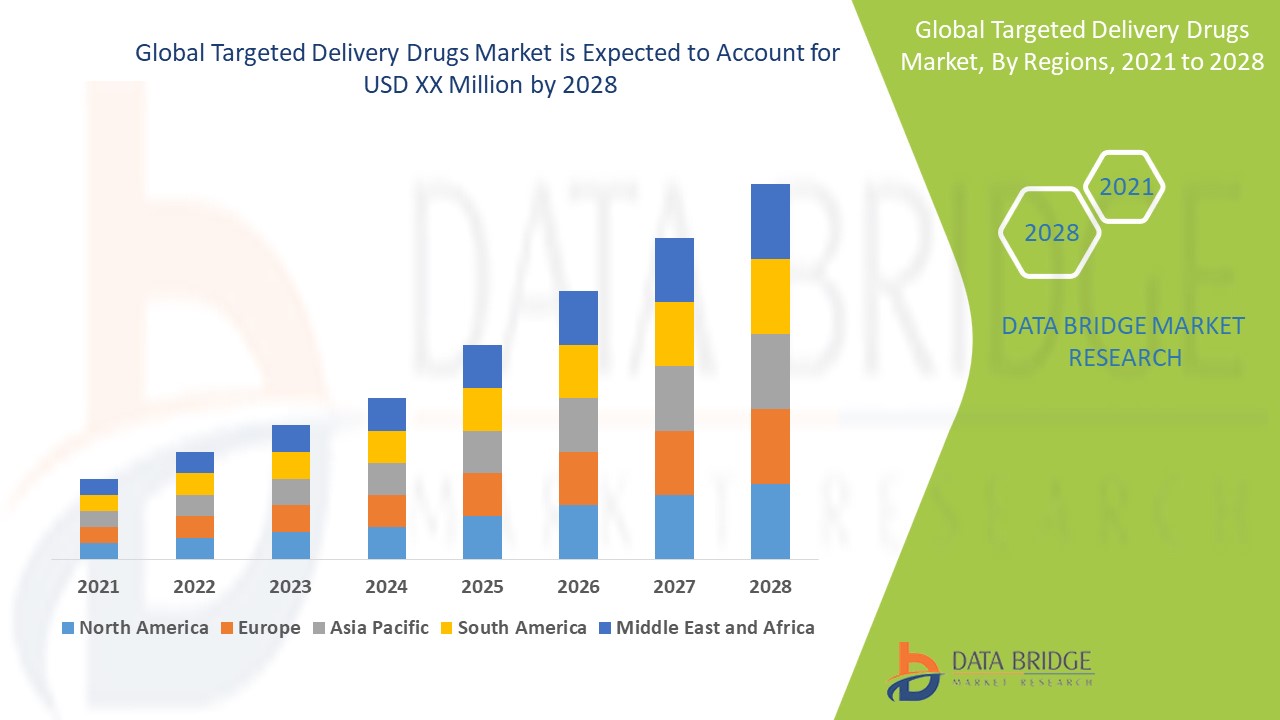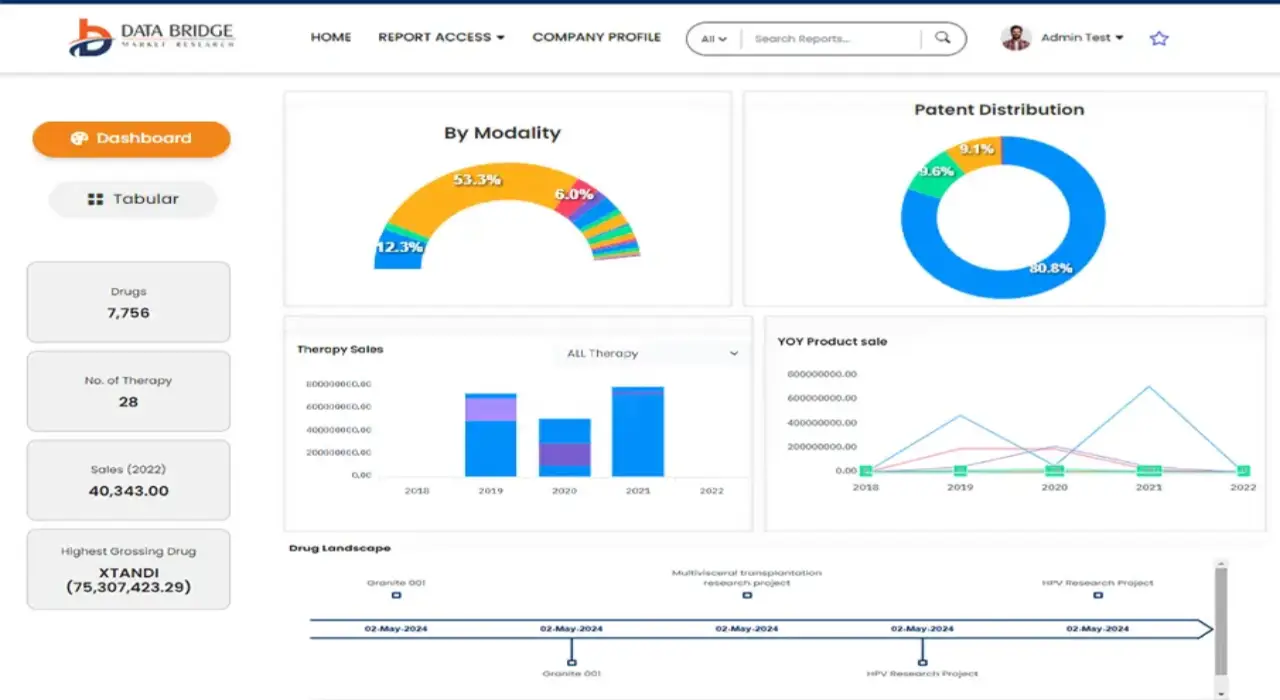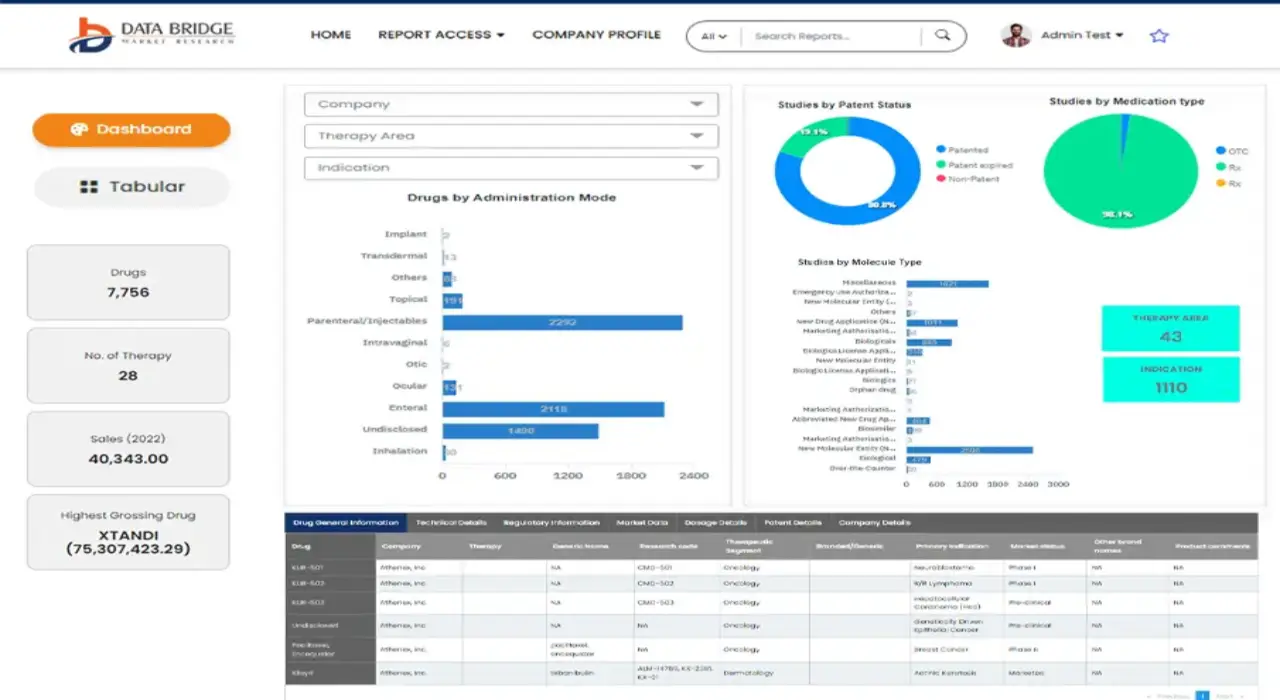Global Targeted Delivery Drugs Market
Market Size in USD Billion
CAGR :
% 
 USD
10.54 Billion
USD
27.99 Billion
2024
2032
USD
10.54 Billion
USD
27.99 Billion
2024
2032
| 2025 –2032 | |
| USD 10.54 Billion | |
| USD 27.99 Billion | |
|
|
|
|
Global Targeted Delivery Drugs Market Segmentation, By Product Type (Pulmonary Drug Delivery, Ocular Drug Delivery, Ocular Nano-Based Drug Delivery Implants, and Drug Eluting Stents), Technology (Nanoparticles, Polymers, Monoclonal antibodies, Gold Nanoparticles-Based Drug Delivery and Imaging), End User (Hospital, Clinic, and Other) – Industry Trends and Forecast to 2032
Targeted Delivery Drugs Market Analysis
The targeted drug delivery market is experiencing significant growth driven by advancements in nanotechnology, biotechnology, and precision medicine. Nanoparticles, liposomes, and dendrimers are being increasingly used to deliver drugs directly to the target site, improving therapeutic efficacy and reducing side effects. One major development is the use of stimuli-responsive systems, where drugs are released in response to specific environmental factors, such as pH or temperature changes at the target site.
In addition, the use of biologically compatible carriers, such as antibodies and aptamers, allows for highly selective drug targeting. These carriers bind to specific receptors on the surface of cells, ensuring that the drug is delivered to the intended tissue or organ.
The growth in this market is also fueled by increasing incidences of chronic diseases, such as cancer and cardiovascular diseases, where targeted therapies offer promising outcomes. Regulatory support and growing investments in research and development are further accelerating innovation, with the market expected to grow significantly over the next decade.
Targeted Delivery Drugs Market Size
The global targeted delivery drugs market size was valued at USD 10.54 billion in 2024 and is projected to reach USD 27.99 billion by 2032, with a CAGR of 12.7% during the forecast period of 2025 to 2032. In addition to the insights on market scenarios such as market value, growth rate, segmentation, geographical coverage, and major players, the market reports curated by the Data Bridge Market Research also include depth expert analysis, patient epidemiology, pipeline analysis, pricing analysis, and regulatory framework.
Targeted Delivery Drugs Market Trends
“Advances in Nanotechnology for Targeted Drug Delivery”
One specific trend in the targeted drug delivery market that is driving its growth is the use of nanotechnology. Nanoparticles, due to their small size and ability to penetrate cellular barriers, are enhancing the precision and efficiency of drug delivery systems. These nanoparticles can be engineered to deliver drugs directly to the affected area, minimizing side effects and maximizing therapeutic effects. For instance, in cancer treatment, nanoparticles are being utilized to target tumors specifically, such as with the use of liposomal chemotherapy drugs such as Doxil. This advancement is contributing significantly to the market’s growth by improving treatment outcomes and reducing systemic toxicity.
Report Scope and Targeted Delivery Drugs Market Segmentation
|
Attributes |
Targeted Delivery Drugs Key Market Insights |
|
Segments Covered |
|
|
Countries Covered |
U.S., Canada and Mexico in North America, Germany, France, U.K., Netherlands, Switzerland, Belgium, Russia, Italy, Spain, Turkey, Rest of Europe in Europe, China, Japan, India, South Korea, Singapore, Malaysia, Australia, Thailand, Indonesia, Philippines, Rest of Asia-Pacific (APAC) in the Asia-Pacific (APAC), Saudi Arabia, U.A.E, South Africa, Egypt, Israel, Rest of Middle East and Africa (MEA) as a part of Middle East and Africa (MEA), Brazil, Argentina and Rest of South America as part of South America |
|
Key Market Players |
F. Hoffmann-La Roche Ltd (Switzerland), Adverum Biotechnologies, Inc. (U.S.), Windtree Therapeutics, Inc. (U.S.), Arrowhead Pharmaceuticals, Inc. (U.S.), Bayer AG (Germany), Lipocine (U.S.), Mankind Pharma (India), Immunocore, Ltd. (U.K.), Keystone Nano, Inc. (U.S.), MultiVir (U.S.), Polyactiva Pty Ltd (Australia), Spark Therapeutics, Inc. (U.S.), and Nektar (U.S.) |
|
Market Opportunities |
|
|
Value Added Data Infosets |
In addition to the insights on market scenarios such as market value, growth rate, segmentation, geographical coverage, and major players, the market reports curated by the Data Bridge Market Research also include depth expert analysis, patient epidemiology, pipeline analysis, pricing analysis, and regulatory framework. |
Targeted Delivery Drugs Market Definition
Targeted drug deliverys is a technique that involves directing medications to specific areas of the body, ensuring that they reach their intended target with minimal impact on healthy tissues. This approach enhances the efficacy of treatments while reducing side effects. It is commonly used in cancer therapy, where drugs are delivered directly to tumor cells, avoiding the surrounding healthy tissue. Targeted delivery can be achieved through various methods, including nanoparticles, liposomes, or antibodies attached to the drug. This method is a significant advancement in precision medicine, offering more effective and safer treatment options for patients.
Targeted Delivery Drugs Market Dynamics
Drivers
- Increased Prevalence of Chronic Diseases
The increased prevalence of chronic diseases, such as cancer, diabetes, and cardiovascular diseases, is a significant driver for the targeted drug delivery market. As these conditions require long-term, precise treatments, traditional drug delivery methods often lead to systemic side effects and inefficiencies. Targeted drug delivery systems address this issue by delivering medication directly to the affected cells or tissues, improving therapeutic efficacy and minimizing harm to healthy organs. For instance, in cancer treatment, targeted therapies such as monoclonal antibodies, such as Herceptin for HER2-positive breast cancer, enhance the drug's effect while reducing side effects. This shift towards precision medicine is fueling the growing demand for advanced drug delivery systems.
- Innovations in Biologics and Gene Therapy
The expansion of biologics and gene therapies has significantly increased the demand for advanced drug delivery systems. These therapies, which include monoclonal antibodies, vaccines, and gene editing techniques such as CRISPR, require precise and targeted delivery to ensure effectiveness and minimize potential risks. For instance, in 2022, Buzzy Patch, launched in 2022, is a pioneering microneedle patch designed to alleviate pain by gradually releasing lidocaine, a local anesthetic. The patch offers a non-invasive and user-friendly method for pain management, particularly in clinical settings where needles or injections are typically required. Its gradual release of lidocaine enhances patient comfort during treatment. These innovations are driving the need for more efficient and precise drug delivery methods.
Opportunities
- Advancements in Nanotechnology
Nanotechnology has revolutionized drug delivery systems by enabling the development of nanoparticles that can target specific cells or tissues with high precision. This innovation offers immense opportunities, particularly in cancer therapy, where traditional treatments often damage healthy tissues. Nanoparticles, due to their small size, can cross biological barriers, deliver drugs directly to tumor sites, and release therapeutics in a controlled manner. This precision not only enhances therapeutic outcomes but also reduces side effects. As nanotechnology continues to evolve, it presents a significant market opportunity, driving the demand for more effective and personalized treatments, thus expanding the targeted drug delivery market globally.
- Development of Smart Drug Delivery Systems
The integration of sensors and responsive drug delivery systems has created significant opportunities in the targeted drug delivery market. These smart systems can monitor the patient's condition in real time, adjusting drug release based on specific physiological responses. This advancement improves treatment precision, ensuring drugs are released at the right time and in the correct dose, enhancing therapeutic outcomes. Moreover, such systems can reduce side effects by minimizing unnecessary exposure to medications. The rise of smart drug delivery platforms is particularly beneficial in chronic disease management, where long-term drug administration is required. This technology offers great potential for personalized medicine, driving growth and innovation in the pharmaceutical industry.
Restraints/Challenges
- High Development Costs
High development costs present a significant challenge for the targeted drug delivery market. The process involves substantial investment in research and development, advanced technologies, and extensive clinical trials to ensure safety and efficacy. This increased financial burden makes it difficult for smaller players to enter the market or sustain long-term operations. In addition, the need for specialized expertise and equipment further escalates costs. As a result, only well-established companies with deep financial resources are often able to navigate the lengthy and expensive development process. This barrier to entry limits innovation and competition within the market, hindering overall growth and accessibility.
- Complexity of Drug Formulation
The complexity of drug formulation in the targeted drug delivery market presents a significant challenge. Developing these systems requires highly specialized formulations that ensure precise control over drug release, which demands advanced technology and expertise. The intricate design of these systems often involves multiple components, including carriers and stabilizers, making the process time-consuming and costly. In addition, achieving the desired specificity for targeted delivery adds another layer of complexity, as the drug must be efficiently delivered to the intended site without affecting healthy tissues. These challenges lead to increased development timelines, elevated research and production costs, and ultimately hinder the widespread adoption and growth of the targeted drug delivery market.
This market report provides details of new recent developments, trade regulations, import-export analysis, production analysis, value chain optimization, market share, impact of domestic and localized market players, analyses opportunities in terms of emerging revenue pockets, changes in market regulations, strategic market growth analysis, market size, category market growths, application niches and dominance, product approvals, product launches, geographic expansions, technological innovations in the market. To gain more info on the market contact Data Bridge Market Research for an Analyst Brief, our team will help you take an informed market decision to achieve market growth.
Targeted Delivery Drugs Market Scope
The market is segmented on the basis of product type, technology and end user. The growth amongst these segments will help you analyze meagre growth segments in the industries and provide the users with a valuable market overview and market insights to help them make strategic decisions for identifying core market applications.
Product Type
- Pulmonary Drug Delivery
- Ocular Drug Delivery
- Ocular Nano-Based Drug Delivery Implants
- Drug Eluting Stents
Technology
- Nanoparticles
- Polymers
- Micelles
- Dendrimers
- Monoclonal antibodies
- Gold Nanoparticles-Based Drug Delivery
- Imaging
End User
- Hospital
- Clinic
- Other
Targeted Delivery Drugs Market Regional Analysis
The market is analysed and market size insights and trends are provided by country, product type, technology and end user as referenced above.
The countries covered in the market report are U.S., Canada, Mexico in North America, Germany, Sweden, Poland, Denmark, Italy, U.K., France, Spain, Netherland, Belgium, Switzerland, Turkey, Russia, Rest of Europe in Europe, Japan, China, India, South Korea, New Zealand, Vietnam, Australia, Singapore, Malaysia, Thailand, Indonesia, Philippines, Rest of Asia-Pacific (APAC) in Asia-Pacific (APAC), Brazil, Argentina, Rest of South America as a part of South America, U.A.E, Saudi Arabia, Oman, Qatar, Kuwait, South Africa, Rest of Middle East and Africa (MEA) as a part of Middle East and Africa (MEA)
North America is expected to dominate the targeted delivery drugs market due to significant investments in research and development, along with the easy availability of advanced technologies. The region's robust healthcare infrastructure and focus on innovation in drug delivery systems further contribute to its leading position in this rapidly growing market.
Asia-Pacific region is expected to expand at a significant growth rate in the targeted delivery drugs market due to rapid advancements in healthcare infrastructure, increasing demand for precision medicine, and growing investment in medical research. The region’s rising patient population and improved healthcare access are driving innovation and market expansion.
The country section of the report also provides individual market impacting factors and changes in regulation in the market domestically that impacts the current and future trends of the market. Data points such as down-stream and upstream value chain analysis, technical trends and porter's five forces analysis, case studies are some of the pointers used to forecast the market scenario for individual countries. Also, the presence and availability of global brands and their challenges faced due to large or scarce competition from local and domestic brands, impact of domestic tariffs and trade routes are considered while providing forecast analysis of the country data.
Targeted Delivery Drugs Market Share
The market competitive landscape provides details by competitor. Details included are company overview, company financials, revenue generated, market potential, investment in research and development, new market initiatives, global presence, production sites and facilities, production capacities, company strengths and weaknesses, product launch, product width and breadth, application dominance. The above data points provided are only related to the companies' focus related to market.
Targeted Delivery Drugs Market Leaders Operating in the Market Are:
- F. Hoffmann-La Roche Ltd (Switzerland)
- Adverum Biotechnologies, Inc. (U.S.)
- Windtree Therapeutics, Inc. (U.S.)
- Arrowhead Pharmaceuticals, Inc. (U.S.)
- Bayer AG (Germany)
- Lipocine (U.S.)
- Mankind Pharma (India)
- Immunocore, Ltd. (U.K.)
- Keystone Nano, Inc. (U.S.)
- MultiVir (U.S.)
- Polyactiva Pty Ltd (Australia)
- Spark Therapeutics, Inc. (U.S.)
- Nektar (U.S.)
Latest Developments in Targeted Delivery Drugs Market
- In June 2022, Gufic Biosciences Ltd introduced an innovative dual-chamber drug delivery system in India, designed for intravenous (IV) administration. These advanced IV bags are constructed from polypropylene and feature peelable aluminum foil. They are specifically designed for storing unstable drugs that require reconstitution just before being administered to patients, enhancing safety and efficiency in medical treatments
- In 2022, The World Health Organization reported that approximately 39 million people were living with HIV globally, including 1.5 million children aged 0-14. In 2022, 630,000 people died from HIV-related causes, but 29.8 million people were on antiretroviral therapy. These statistics underscore the increasing demand for advanced drug delivery systems to manage HIV treatment effectively
- In 2023, the U.S. FDA approved ZYNTEGLO, a breakthrough microneedle patch designed to deliver the anti-nausea drug thioperamide for managing post-surgery sickness. This approval marks a significant advancement in drug delivery technologies, offering a non-invasive and effective solution to address nausea in post-operative patients, demonstrating the growing potential of microneedle therapies
- In 2022, Buzzy Patch, launched in 2022, is a pioneering microneedle patch designed to alleviate pain by gradually releasing lidocaine, a local anesthetic. The patch offers a non-invasive and user-friendly method for pain management, particularly in clinical settings where needles or injections are typically required. Its gradual release of lidocaine enhances patient comfort during treatment
- In March 2022, Eucure Biopharma, a subsidiary of Biocytogen, disclosed the first patient dose for a phase I clinical trial in Australia, testing YH002, an anti-OX40 monoclonal antibody, in combination with YH001, an anti-CTLA-4 monoclonal antibody. The trial aims to explore the efficacy and safety of these promising treatments in advanced cancers, marking an important milestone in oncology research
- In February 2022, Transcenta Holding Limited initiated phase IIa clinical trials in February 2022 to investigate TST001, a claudin 18.2 monoclonal antibody, in combination with cisplatin and gemcitabine as a first-line therapy for biliary tract cancer. This research aims to improve treatment outcomes for patients suffering from this aggressive and often difficult-to-treat cancer type, offering hope for new therapeutic approaches
SKU-
Get online access to the report on the World's First Market Intelligence Cloud
- Interactive Data Analysis Dashboard
- Company Analysis Dashboard for high growth potential opportunities
- Research Analyst Access for customization & queries
- Competitor Analysis with Interactive dashboard
- Latest News, Updates & Trend analysis
- Harness the Power of Benchmark Analysis for Comprehensive Competitor Tracking
Research Methodology
Data collection and base year analysis are done using data collection modules with large sample sizes. The stage includes obtaining market information or related data through various sources and strategies. It includes examining and planning all the data acquired from the past in advance. It likewise envelops the examination of information inconsistencies seen across different information sources. The market data is analysed and estimated using market statistical and coherent models. Also, market share analysis and key trend analysis are the major success factors in the market report. To know more, please request an analyst call or drop down your inquiry.
The key research methodology used by DBMR research team is data triangulation which involves data mining, analysis of the impact of data variables on the market and primary (industry expert) validation. Data models include Vendor Positioning Grid, Market Time Line Analysis, Market Overview and Guide, Company Positioning Grid, Patent Analysis, Pricing Analysis, Company Market Share Analysis, Standards of Measurement, Global versus Regional and Vendor Share Analysis. To know more about the research methodology, drop in an inquiry to speak to our industry experts.
Customization Available
Data Bridge Market Research is a leader in advanced formative research. We take pride in servicing our existing and new customers with data and analysis that match and suits their goal. The report can be customized to include price trend analysis of target brands understanding the market for additional countries (ask for the list of countries), clinical trial results data, literature review, refurbished market and product base analysis. Market analysis of target competitors can be analyzed from technology-based analysis to market portfolio strategies. We can add as many competitors that you require data about in the format and data style you are looking for. Our team of analysts can also provide you data in crude raw excel files pivot tables (Fact book) or can assist you in creating presentations from the data sets available in the report.













